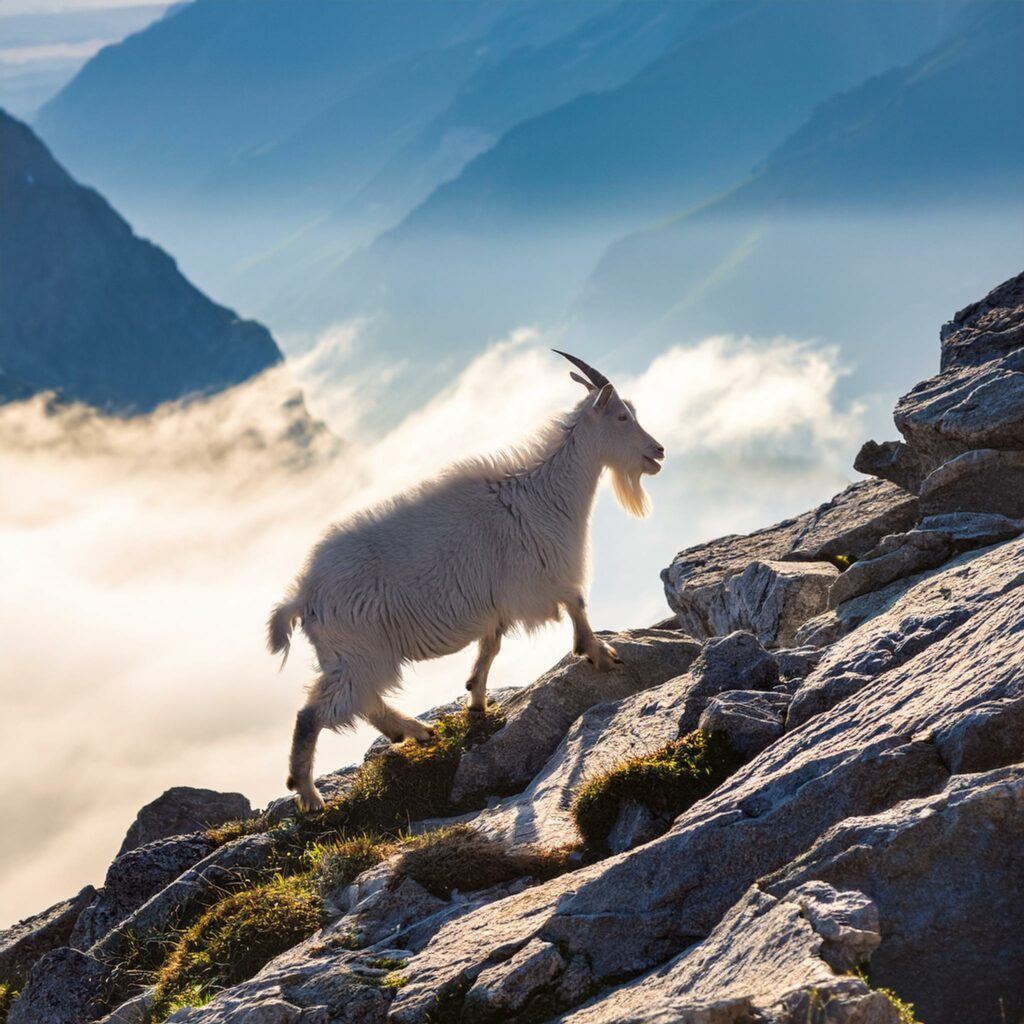Mountain goats are extraordinary creatures that live in some of the most rugged and remote landscapes on Earth. Found primarily in North America, especially in the Rocky Mountains and Cascade Range, these animals are true climbers and adapt seamlessly to their rocky homes.
These goats look pretty unique. They sport a thick, white coat that blends perfectly with snow-covered rocks, making them hard to spot from a distance. This coat isn’t just for looks – it provides insulation against the harsh, cold temperatures they often face. Their hooves are another remarkable feature. With a rough pad in the center and sharp outer edges, these hooves act like natural climbing shoes, allowing them to get an impressive grip on rocky surfaces.
It is so rare that you would see a mountain goat up close, a good set of binoculars is important if you want to observe them from afar. Click on the banner below and you will discover a wide range of well made binoculars and a range of other products>>>>>>
It’s not just their physical traits that make them fascinating. Mountain goats are known for their solitary and elusive nature. Unlike other herd animals, they often prefer to stay in small groups or venture alone. This lone-wolf attitude isn’t random; it helps them avoid predators and find food in sparse, tricky terrains.
Mountain goats play a significant role in their ecosystems. As they move, they graze on various plants, helping to maintain vegetation balance in alpine environments. Their droppings also add nutrients to the soil, supporting plant growth. Birdwatchers and nature enthusiasts often find them intriguing not just for their climbing skills but for how they subtly influence the landscapes they inhabit.
Scaling Heights: How Mountain Goats Conquer Rugged Terrain
Mountain goats are known for their incredible climbing skills. Navigating cliffs that seem impossible to us, they make it look easy. It’s not magic, though; it’s a mix of unique abilities and adaptations that let them take on these challenging terrains.

Their climbing prowess starts with their hooves. Unlike most animals, mountain goats have specialized hooves with a hard outer casing and a soft, grippy pad. This combo works like a natural rock-climbing shoe, letting them get a firm hold on even the smallest ledges. It’s fascinating to watch them move with such ease and agility.
Their muscular build also plays a critical role. Strong shoulders and hind legs give them the power to leap up or down steep surfaces. These muscles aren’t just for show – they’re essential for making those daring jumps that often leave us in awe.
Survival in such harsh environments requires more than just physical strength. These goats have developed keen problem-solving skills and excellent memory. They remember safe routes and avoid spots where they might have slipped in the past. They also have a knack for judging the stability of rocks and choosing the safest path.
Stories of mountain goats tackling sheer cliffs might seem like tall tales, but they’re well-documented. In Glacier National Park, for instance, rangers have reported goats traversing nearly vertical rock faces with unmatched precision. It’s a beautiful spectacle showing just how well-adapted these animals are to their surroundings.
So, when thinking about mountain goats, it’s not just about brute strength or courage. Their success in scaling heights comes from a mix of physical adaptations and smart survival strategies. Next time you see one perched gracefully on a cliffside, you’ll know it’s a testament to nature’s incredible design.
Social Structure and Interaction in Mountain Goat Society
Mountain goats might look like the lone wanderers of the wild, but their social lives are surprisingly complex. They organize themselves in dynamic ways, showing that their relationships are as rugged and fascinating as the landscapes they roam.

Mountain goats typically form small herds, particularly during certain seasons. These groups consist mainly of females and their young, with males often living solo or in bachelor groups. The herd structure shifts with the seasons, especially during mating periods when males temporarily rejoin to compete for females.
Mating rituals among mountain goats are quite a spectacle. With high-pitched bleats and impressive horn clashes, males demonstrate their strength and stamina. These battles, while intense, rarely result in serious injury but do establish a clear social hierarchy.
Parenthood in the mountains is another story of dedication. Female goats, known as nannies, are incredibly protective of their kids. They guide them through the treacherous terrain, teaching crucial survival skills from a young age. It’s common to see a mom and her kid navigating slopes together, the youngster mimicking every move its mom makes.
Communication within these groups is key. Mountain goats use a range of vocalizations and body language to signal danger, establish dominance, or simply stay in touch. These signals help maintain the cohesion of the group, which is critical for their survival in such unforgiving environments.
Understanding their social structures changes the way we see these otherwise solitary-looking creatures. Mountain goats have a rich, albeit subtle, social life that ensures the herd’s overall well-being and adaptability. It’s a beautiful reminder that even the rugged individualists of the animal world depend on each other in remarkable ways.
Conservation and Challenges Faced by Mountain Goats
Mountain goats face numerous challenges that threaten their survival. Climate change tops the list, altering the delicate balance of their alpine habitats. As temperatures rise, vegetation patterns shift, which can disrupt their food supply and make their environments less hospitable.
Human activities also pose significant risks. Increased hiking, tourism, and even development in mountain areas can encroach on their habitats. Such disturbances not only lead to habitat loss but can also increase stress levels in these typically solitary animals, affecting their health and reproduction.
Despite these challenges, there are shining examples of effective conservation efforts. Many national parks and wildlife preserves have implemented measures to protect mountain goat populations. Restricted access to certain areas, especially during mating and birthing seasons, helps minimize human impact. Research and monitoring programs provide valuable data, guiding future conservation strategies.

Working together can make a difference. Simple actions like respecting wildlife guidelines when hiking or supporting organizations focused on wildlife conservation can help. Spreading awareness about the challenges faced by mountain goats is equally important. The more people understand the importance of these animals and their habitats, the stronger the collective effort to protect them can be.
These magnificent climbers have adapted to some of the harshest environments on Earth, showing extraordinary resilience. But they need our support to continue thriving. By understanding the challenges they face and actively participating in conservation efforts, we can ensure that mountain goats remain a part of our natural world for generations to come.






